EGB123: Comparative Assessment of Major Civil Engineering Projects
VerifiedAdded on 2023/06/03
|24
|7494
|288
Report
AI Summary
This report provides a comprehensive comparative assessment of the Brisbane Metro project, a significant infrastructure initiative aimed at transforming public transportation in South East Queensland (SEQ). The assessment, conducted for SEQTrans, a government consortium, examines various aspects of the project including its needs, lifecycle stages (planning, procurement, design, development, delivery, operation, and retirement), civil engineering systems, project stewardship, and project values (economic, social, sustainability, and political impacts). The report compares the Brisbane Metro with the Cross River Rail project, highlighting their complementary nature. The analysis includes detailed discussions on project elements such as initial planning, procurement processes, design considerations, development milestones, delivery strategies, and operational and maintenance plans, as well as a discussion of the project's lifecycle and its implications for the region's growth and infrastructure needs. The report concludes with recommendations to ensure the successful implementation of both projects, contributing to informed decision-making by SEQTrans.
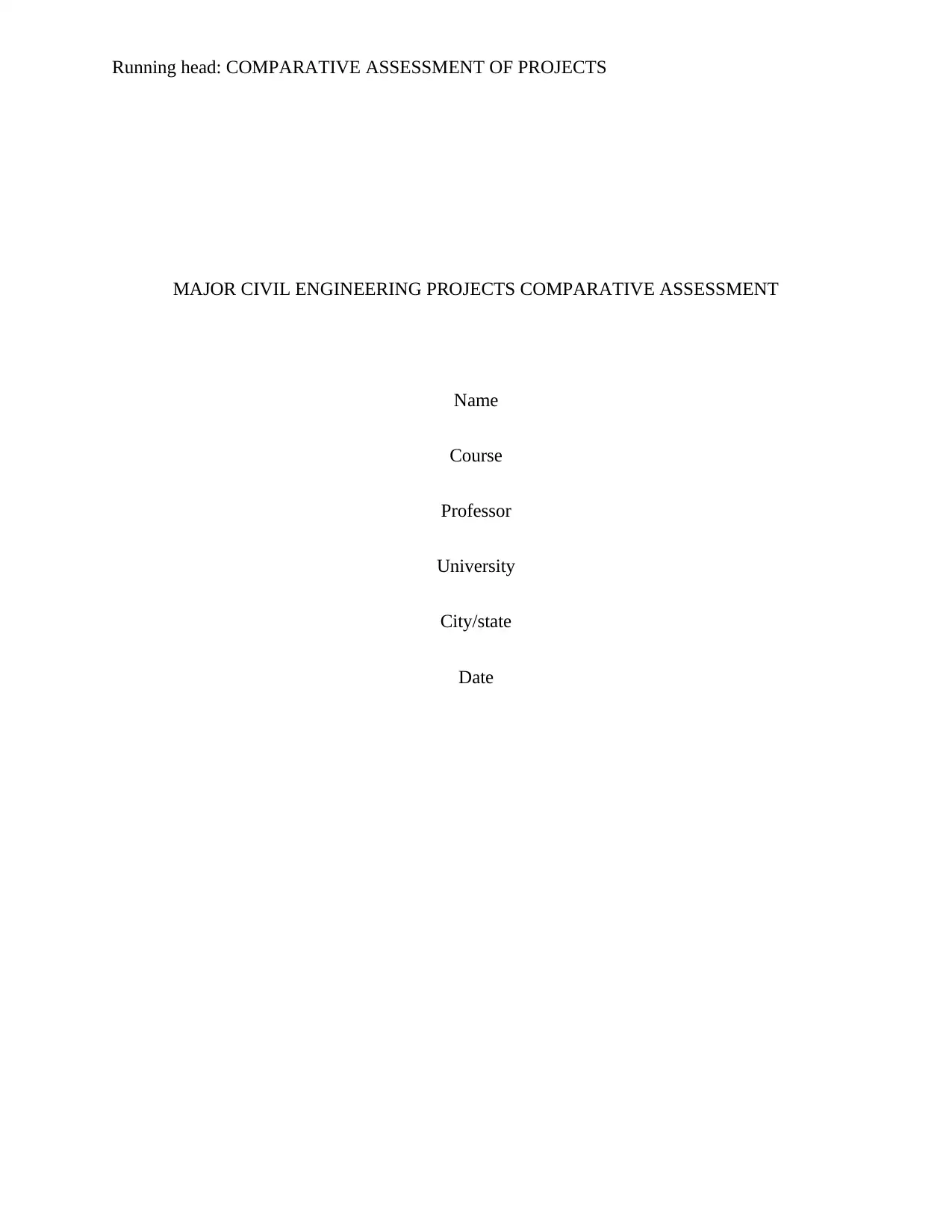
Running head: COMPARATIVE ASSESSMENT OF PROJECTS
MAJOR CIVIL ENGINEERING PROJECTS COMPARATIVE ASSESSMENT
Name
Course
Professor
University
City/state
Date
MAJOR CIVIL ENGINEERING PROJECTS COMPARATIVE ASSESSMENT
Name
Course
Professor
University
City/state
Date
Paraphrase This Document
Need a fresh take? Get an instant paraphrase of this document with our AI Paraphraser
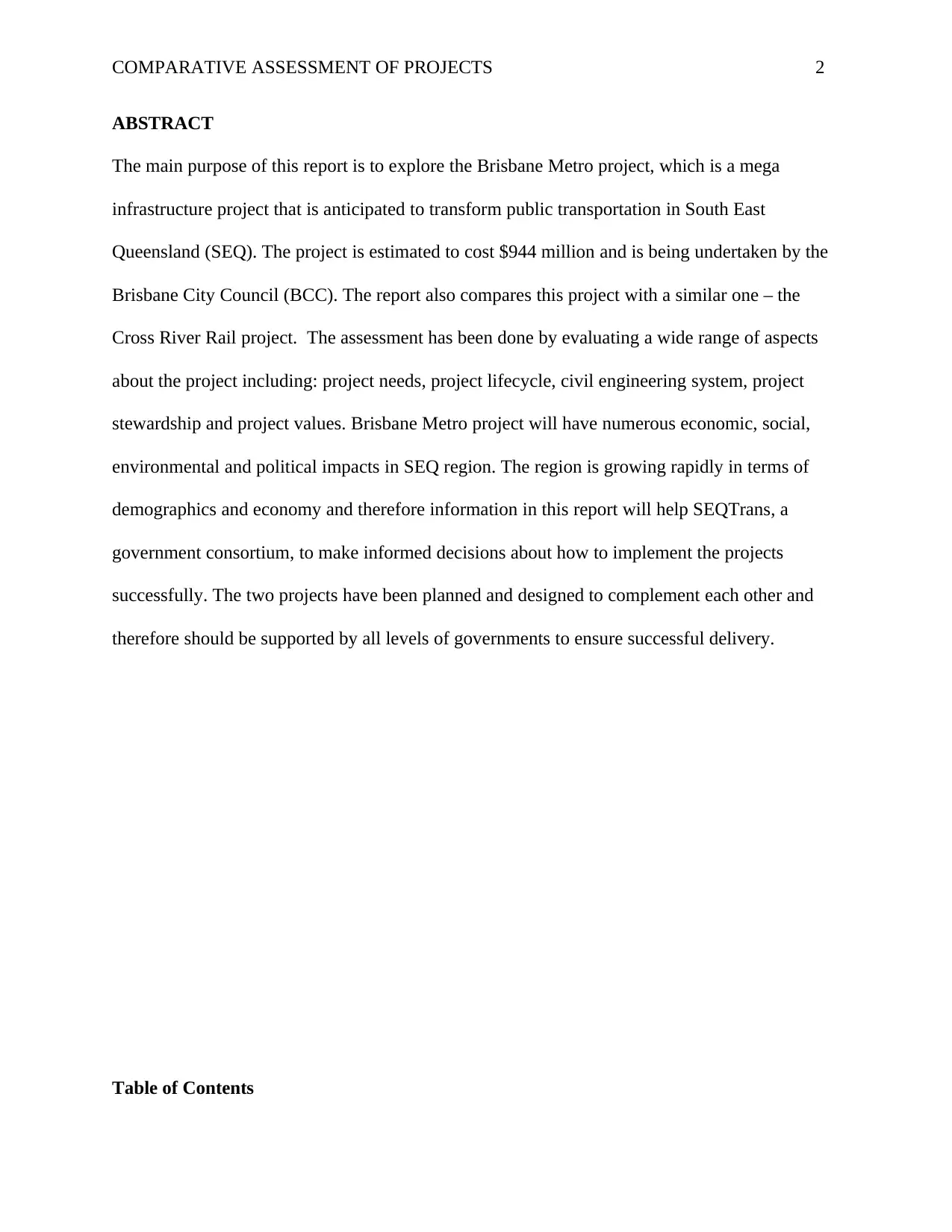
COMPARATIVE ASSESSMENT OF PROJECTS 2
ABSTRACT
The main purpose of this report is to explore the Brisbane Metro project, which is a mega
infrastructure project that is anticipated to transform public transportation in South East
Queensland (SEQ). The project is estimated to cost $944 million and is being undertaken by the
Brisbane City Council (BCC). The report also compares this project with a similar one – the
Cross River Rail project. The assessment has been done by evaluating a wide range of aspects
about the project including: project needs, project lifecycle, civil engineering system, project
stewardship and project values. Brisbane Metro project will have numerous economic, social,
environmental and political impacts in SEQ region. The region is growing rapidly in terms of
demographics and economy and therefore information in this report will help SEQTrans, a
government consortium, to make informed decisions about how to implement the projects
successfully. The two projects have been planned and designed to complement each other and
therefore should be supported by all levels of governments to ensure successful delivery.
Table of Contents
ABSTRACT
The main purpose of this report is to explore the Brisbane Metro project, which is a mega
infrastructure project that is anticipated to transform public transportation in South East
Queensland (SEQ). The project is estimated to cost $944 million and is being undertaken by the
Brisbane City Council (BCC). The report also compares this project with a similar one – the
Cross River Rail project. The assessment has been done by evaluating a wide range of aspects
about the project including: project needs, project lifecycle, civil engineering system, project
stewardship and project values. Brisbane Metro project will have numerous economic, social,
environmental and political impacts in SEQ region. The region is growing rapidly in terms of
demographics and economy and therefore information in this report will help SEQTrans, a
government consortium, to make informed decisions about how to implement the projects
successfully. The two projects have been planned and designed to complement each other and
therefore should be supported by all levels of governments to ensure successful delivery.
Table of Contents
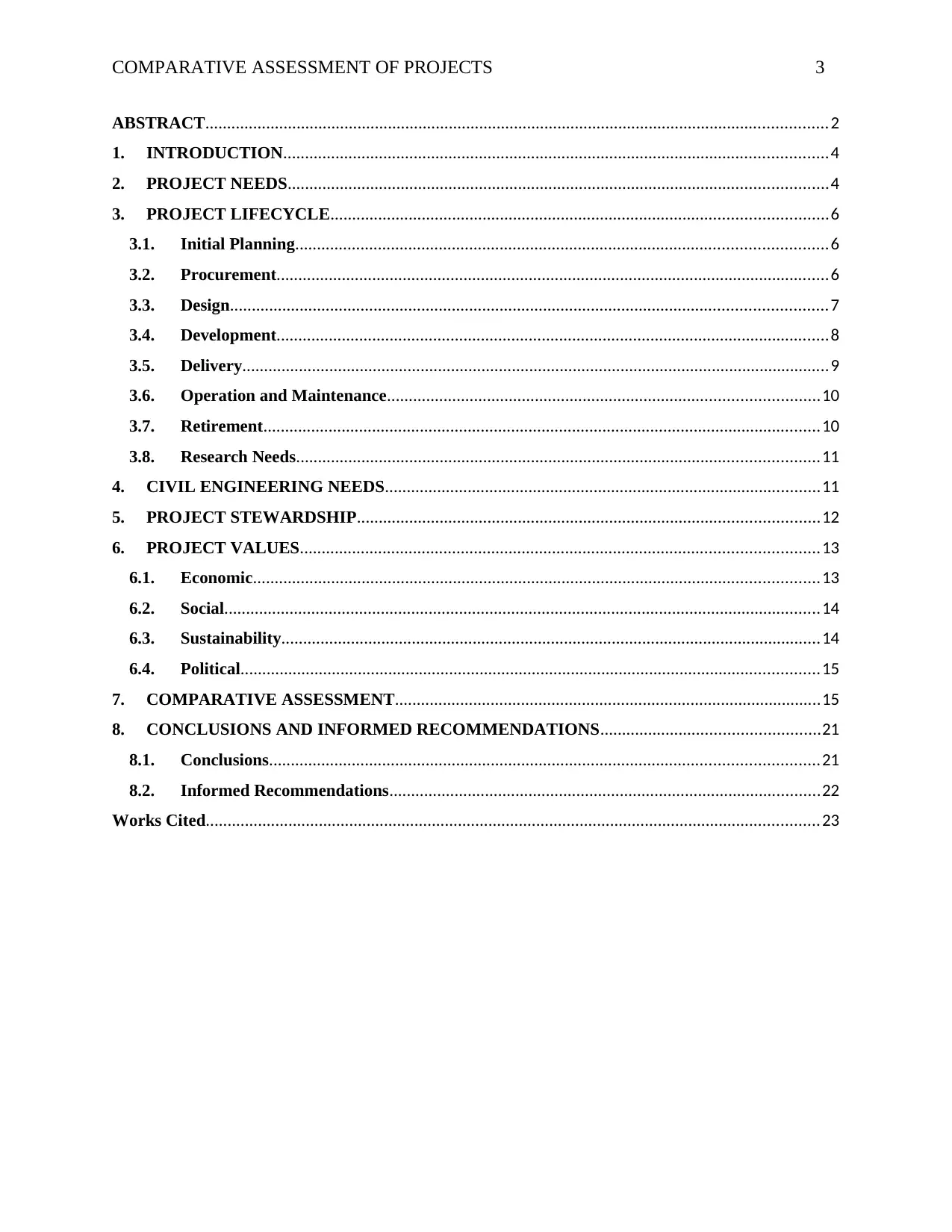
COMPARATIVE ASSESSMENT OF PROJECTS 3
ABSTRACT...............................................................................................................................................2
1. INTRODUCTION.............................................................................................................................4
2. PROJECT NEEDS............................................................................................................................4
3. PROJECT LIFECYCLE..................................................................................................................6
3.1. Initial Planning..........................................................................................................................6
3.2. Procurement...............................................................................................................................6
3.3. Design.........................................................................................................................................7
3.4. Development...............................................................................................................................8
3.5. Delivery.......................................................................................................................................9
3.6. Operation and Maintenance...................................................................................................10
3.7. Retirement................................................................................................................................10
3.8. Research Needs........................................................................................................................11
4. CIVIL ENGINEERING NEEDS....................................................................................................11
5. PROJECT STEWARDSHIP..........................................................................................................12
6. PROJECT VALUES.......................................................................................................................13
6.1. Economic..................................................................................................................................13
6.2. Social.........................................................................................................................................14
6.3. Sustainability............................................................................................................................14
6.4. Political.....................................................................................................................................15
7. COMPARATIVE ASSESSMENT..................................................................................................15
8. CONCLUSIONS AND INFORMED RECOMMENDATIONS..................................................21
8.1. Conclusions..............................................................................................................................21
8.2. Informed Recommendations...................................................................................................22
Works Cited.............................................................................................................................................23
ABSTRACT...............................................................................................................................................2
1. INTRODUCTION.............................................................................................................................4
2. PROJECT NEEDS............................................................................................................................4
3. PROJECT LIFECYCLE..................................................................................................................6
3.1. Initial Planning..........................................................................................................................6
3.2. Procurement...............................................................................................................................6
3.3. Design.........................................................................................................................................7
3.4. Development...............................................................................................................................8
3.5. Delivery.......................................................................................................................................9
3.6. Operation and Maintenance...................................................................................................10
3.7. Retirement................................................................................................................................10
3.8. Research Needs........................................................................................................................11
4. CIVIL ENGINEERING NEEDS....................................................................................................11
5. PROJECT STEWARDSHIP..........................................................................................................12
6. PROJECT VALUES.......................................................................................................................13
6.1. Economic..................................................................................................................................13
6.2. Social.........................................................................................................................................14
6.3. Sustainability............................................................................................................................14
6.4. Political.....................................................................................................................................15
7. COMPARATIVE ASSESSMENT..................................................................................................15
8. CONCLUSIONS AND INFORMED RECOMMENDATIONS..................................................21
8.1. Conclusions..............................................................................................................................21
8.2. Informed Recommendations...................................................................................................22
Works Cited.............................................................................................................................................23
⊘ This is a preview!⊘
Do you want full access?
Subscribe today to unlock all pages.

Trusted by 1+ million students worldwide
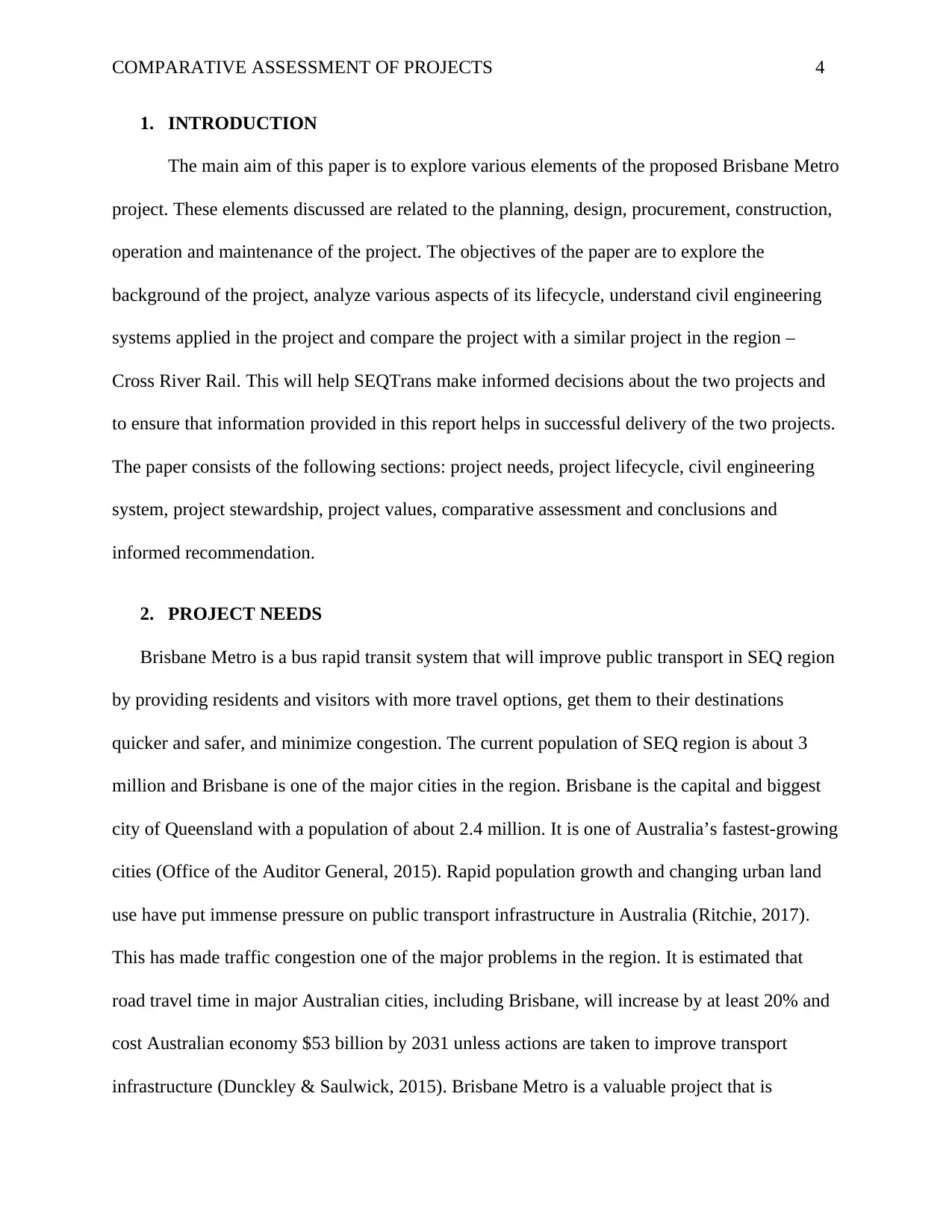
COMPARATIVE ASSESSMENT OF PROJECTS 4
1. INTRODUCTION
The main aim of this paper is to explore various elements of the proposed Brisbane Metro
project. These elements discussed are related to the planning, design, procurement, construction,
operation and maintenance of the project. The objectives of the paper are to explore the
background of the project, analyze various aspects of its lifecycle, understand civil engineering
systems applied in the project and compare the project with a similar project in the region –
Cross River Rail. This will help SEQTrans make informed decisions about the two projects and
to ensure that information provided in this report helps in successful delivery of the two projects.
The paper consists of the following sections: project needs, project lifecycle, civil engineering
system, project stewardship, project values, comparative assessment and conclusions and
informed recommendation.
2. PROJECT NEEDS
Brisbane Metro is a bus rapid transit system that will improve public transport in SEQ region
by providing residents and visitors with more travel options, get them to their destinations
quicker and safer, and minimize congestion. The current population of SEQ region is about 3
million and Brisbane is one of the major cities in the region. Brisbane is the capital and biggest
city of Queensland with a population of about 2.4 million. It is one of Australia’s fastest-growing
cities (Office of the Auditor General, 2015). Rapid population growth and changing urban land
use have put immense pressure on public transport infrastructure in Australia (Ritchie, 2017).
This has made traffic congestion one of the major problems in the region. It is estimated that
road travel time in major Australian cities, including Brisbane, will increase by at least 20% and
cost Australian economy $53 billion by 2031 unless actions are taken to improve transport
infrastructure (Dunckley & Saulwick, 2015). Brisbane Metro is a valuable project that is
1. INTRODUCTION
The main aim of this paper is to explore various elements of the proposed Brisbane Metro
project. These elements discussed are related to the planning, design, procurement, construction,
operation and maintenance of the project. The objectives of the paper are to explore the
background of the project, analyze various aspects of its lifecycle, understand civil engineering
systems applied in the project and compare the project with a similar project in the region –
Cross River Rail. This will help SEQTrans make informed decisions about the two projects and
to ensure that information provided in this report helps in successful delivery of the two projects.
The paper consists of the following sections: project needs, project lifecycle, civil engineering
system, project stewardship, project values, comparative assessment and conclusions and
informed recommendation.
2. PROJECT NEEDS
Brisbane Metro is a bus rapid transit system that will improve public transport in SEQ region
by providing residents and visitors with more travel options, get them to their destinations
quicker and safer, and minimize congestion. The current population of SEQ region is about 3
million and Brisbane is one of the major cities in the region. Brisbane is the capital and biggest
city of Queensland with a population of about 2.4 million. It is one of Australia’s fastest-growing
cities (Office of the Auditor General, 2015). Rapid population growth and changing urban land
use have put immense pressure on public transport infrastructure in Australia (Ritchie, 2017).
This has made traffic congestion one of the major problems in the region. It is estimated that
road travel time in major Australian cities, including Brisbane, will increase by at least 20% and
cost Australian economy $53 billion by 2031 unless actions are taken to improve transport
infrastructure (Dunckley & Saulwick, 2015). Brisbane Metro is a valuable project that is
Paraphrase This Document
Need a fresh take? Get an instant paraphrase of this document with our AI Paraphraser
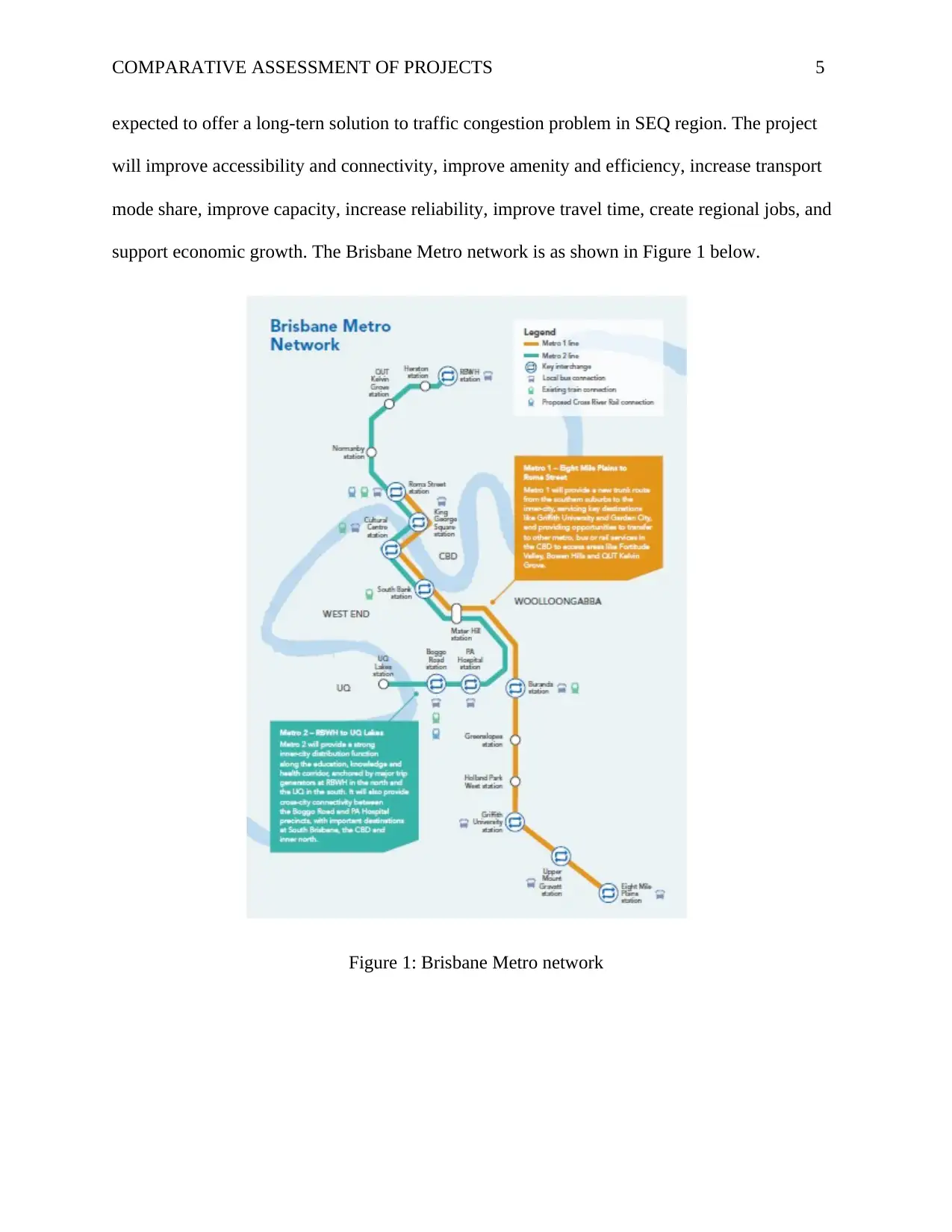
COMPARATIVE ASSESSMENT OF PROJECTS 5
expected to offer a long-tern solution to traffic congestion problem in SEQ region. The project
will improve accessibility and connectivity, improve amenity and efficiency, increase transport
mode share, improve capacity, increase reliability, improve travel time, create regional jobs, and
support economic growth. The Brisbane Metro network is as shown in Figure 1 below.
Figure 1: Brisbane Metro network
expected to offer a long-tern solution to traffic congestion problem in SEQ region. The project
will improve accessibility and connectivity, improve amenity and efficiency, increase transport
mode share, improve capacity, increase reliability, improve travel time, create regional jobs, and
support economic growth. The Brisbane Metro network is as shown in Figure 1 below.
Figure 1: Brisbane Metro network
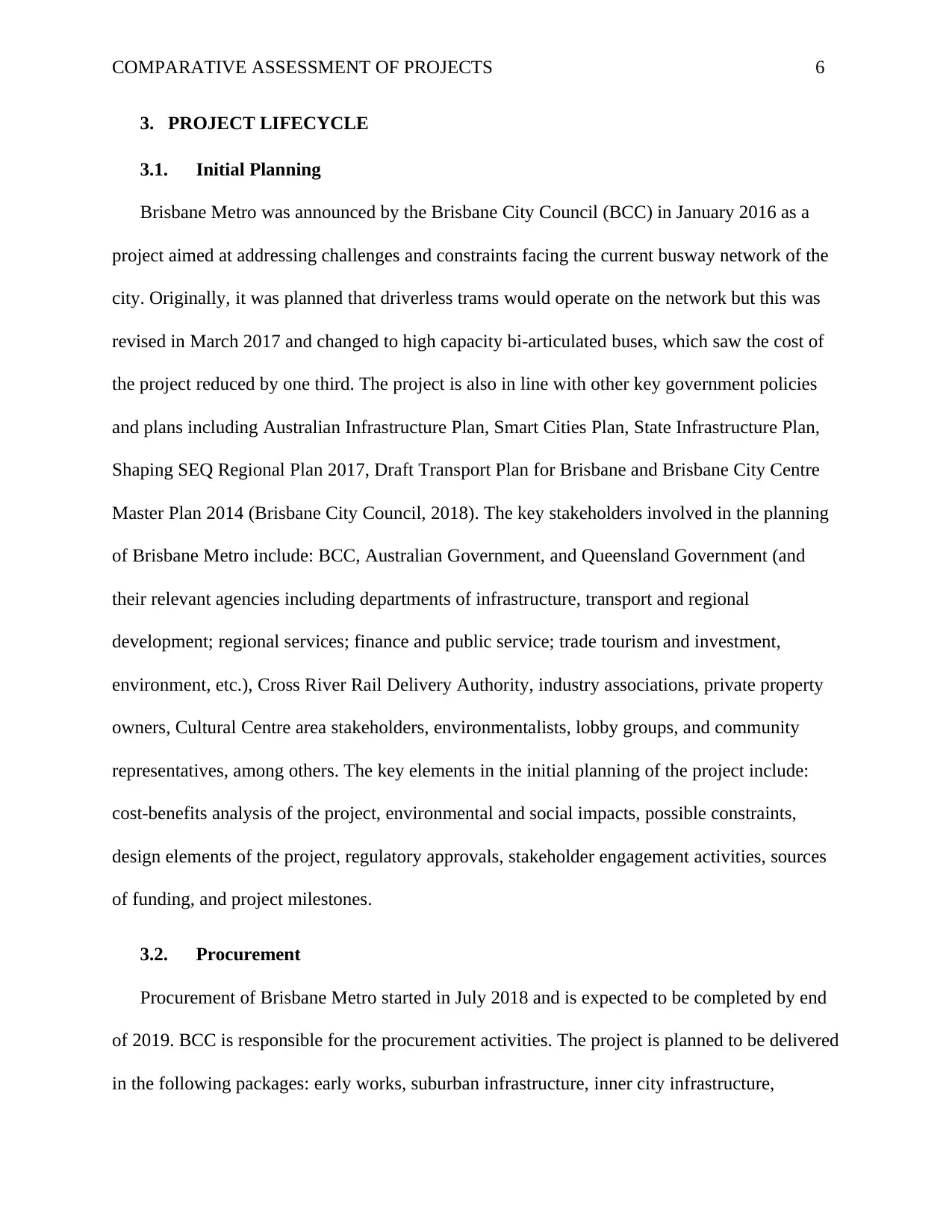
COMPARATIVE ASSESSMENT OF PROJECTS 6
3. PROJECT LIFECYCLE
3.1. Initial Planning
Brisbane Metro was announced by the Brisbane City Council (BCC) in January 2016 as a
project aimed at addressing challenges and constraints facing the current busway network of the
city. Originally, it was planned that driverless trams would operate on the network but this was
revised in March 2017 and changed to high capacity bi-articulated buses, which saw the cost of
the project reduced by one third. The project is also in line with other key government policies
and plans including Australian Infrastructure Plan, Smart Cities Plan, State Infrastructure Plan,
Shaping SEQ Regional Plan 2017, Draft Transport Plan for Brisbane and Brisbane City Centre
Master Plan 2014 (Brisbane City Council, 2018). The key stakeholders involved in the planning
of Brisbane Metro include: BCC, Australian Government, and Queensland Government (and
their relevant agencies including departments of infrastructure, transport and regional
development; regional services; finance and public service; trade tourism and investment,
environment, etc.), Cross River Rail Delivery Authority, industry associations, private property
owners, Cultural Centre area stakeholders, environmentalists, lobby groups, and community
representatives, among others. The key elements in the initial planning of the project include:
cost-benefits analysis of the project, environmental and social impacts, possible constraints,
design elements of the project, regulatory approvals, stakeholder engagement activities, sources
of funding, and project milestones.
3.2. Procurement
Procurement of Brisbane Metro started in July 2018 and is expected to be completed by end
of 2019. BCC is responsible for the procurement activities. The project is planned to be delivered
in the following packages: early works, suburban infrastructure, inner city infrastructure,
3. PROJECT LIFECYCLE
3.1. Initial Planning
Brisbane Metro was announced by the Brisbane City Council (BCC) in January 2016 as a
project aimed at addressing challenges and constraints facing the current busway network of the
city. Originally, it was planned that driverless trams would operate on the network but this was
revised in March 2017 and changed to high capacity bi-articulated buses, which saw the cost of
the project reduced by one third. The project is also in line with other key government policies
and plans including Australian Infrastructure Plan, Smart Cities Plan, State Infrastructure Plan,
Shaping SEQ Regional Plan 2017, Draft Transport Plan for Brisbane and Brisbane City Centre
Master Plan 2014 (Brisbane City Council, 2018). The key stakeholders involved in the planning
of Brisbane Metro include: BCC, Australian Government, and Queensland Government (and
their relevant agencies including departments of infrastructure, transport and regional
development; regional services; finance and public service; trade tourism and investment,
environment, etc.), Cross River Rail Delivery Authority, industry associations, private property
owners, Cultural Centre area stakeholders, environmentalists, lobby groups, and community
representatives, among others. The key elements in the initial planning of the project include:
cost-benefits analysis of the project, environmental and social impacts, possible constraints,
design elements of the project, regulatory approvals, stakeholder engagement activities, sources
of funding, and project milestones.
3.2. Procurement
Procurement of Brisbane Metro started in July 2018 and is expected to be completed by end
of 2019. BCC is responsible for the procurement activities. The project is planned to be delivered
in the following packages: early works, suburban infrastructure, inner city infrastructure,
⊘ This is a preview!⊘
Do you want full access?
Subscribe today to unlock all pages.

Trusted by 1+ million students worldwide
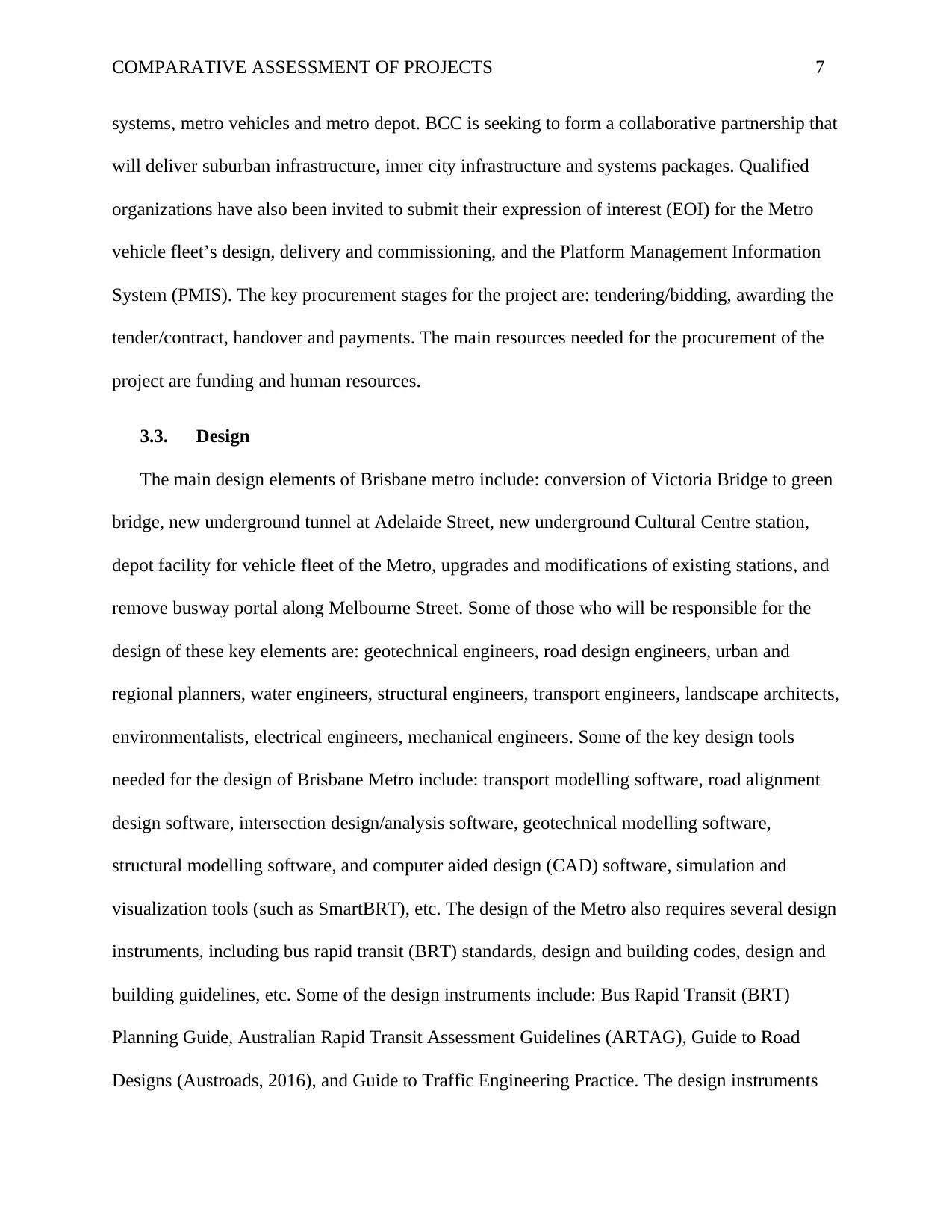
COMPARATIVE ASSESSMENT OF PROJECTS 7
systems, metro vehicles and metro depot. BCC is seeking to form a collaborative partnership that
will deliver suburban infrastructure, inner city infrastructure and systems packages. Qualified
organizations have also been invited to submit their expression of interest (EOI) for the Metro
vehicle fleet’s design, delivery and commissioning, and the Platform Management Information
System (PMIS). The key procurement stages for the project are: tendering/bidding, awarding the
tender/contract, handover and payments. The main resources needed for the procurement of the
project are funding and human resources.
3.3. Design
The main design elements of Brisbane metro include: conversion of Victoria Bridge to green
bridge, new underground tunnel at Adelaide Street, new underground Cultural Centre station,
depot facility for vehicle fleet of the Metro, upgrades and modifications of existing stations, and
remove busway portal along Melbourne Street. Some of those who will be responsible for the
design of these key elements are: geotechnical engineers, road design engineers, urban and
regional planners, water engineers, structural engineers, transport engineers, landscape architects,
environmentalists, electrical engineers, mechanical engineers. Some of the key design tools
needed for the design of Brisbane Metro include: transport modelling software, road alignment
design software, intersection design/analysis software, geotechnical modelling software,
structural modelling software, and computer aided design (CAD) software, simulation and
visualization tools (such as SmartBRT), etc. The design of the Metro also requires several design
instruments, including bus rapid transit (BRT) standards, design and building codes, design and
building guidelines, etc. Some of the design instruments include: Bus Rapid Transit (BRT)
Planning Guide, Australian Rapid Transit Assessment Guidelines (ARTAG), Guide to Road
Designs (Austroads, 2016), and Guide to Traffic Engineering Practice. The design instruments
systems, metro vehicles and metro depot. BCC is seeking to form a collaborative partnership that
will deliver suburban infrastructure, inner city infrastructure and systems packages. Qualified
organizations have also been invited to submit their expression of interest (EOI) for the Metro
vehicle fleet’s design, delivery and commissioning, and the Platform Management Information
System (PMIS). The key procurement stages for the project are: tendering/bidding, awarding the
tender/contract, handover and payments. The main resources needed for the procurement of the
project are funding and human resources.
3.3. Design
The main design elements of Brisbane metro include: conversion of Victoria Bridge to green
bridge, new underground tunnel at Adelaide Street, new underground Cultural Centre station,
depot facility for vehicle fleet of the Metro, upgrades and modifications of existing stations, and
remove busway portal along Melbourne Street. Some of those who will be responsible for the
design of these key elements are: geotechnical engineers, road design engineers, urban and
regional planners, water engineers, structural engineers, transport engineers, landscape architects,
environmentalists, electrical engineers, mechanical engineers. Some of the key design tools
needed for the design of Brisbane Metro include: transport modelling software, road alignment
design software, intersection design/analysis software, geotechnical modelling software,
structural modelling software, and computer aided design (CAD) software, simulation and
visualization tools (such as SmartBRT), etc. The design of the Metro also requires several design
instruments, including bus rapid transit (BRT) standards, design and building codes, design and
building guidelines, etc. Some of the design instruments include: Bus Rapid Transit (BRT)
Planning Guide, Australian Rapid Transit Assessment Guidelines (ARTAG), Guide to Road
Designs (Austroads, 2016), and Guide to Traffic Engineering Practice. The design instruments
Paraphrase This Document
Need a fresh take? Get an instant paraphrase of this document with our AI Paraphraser
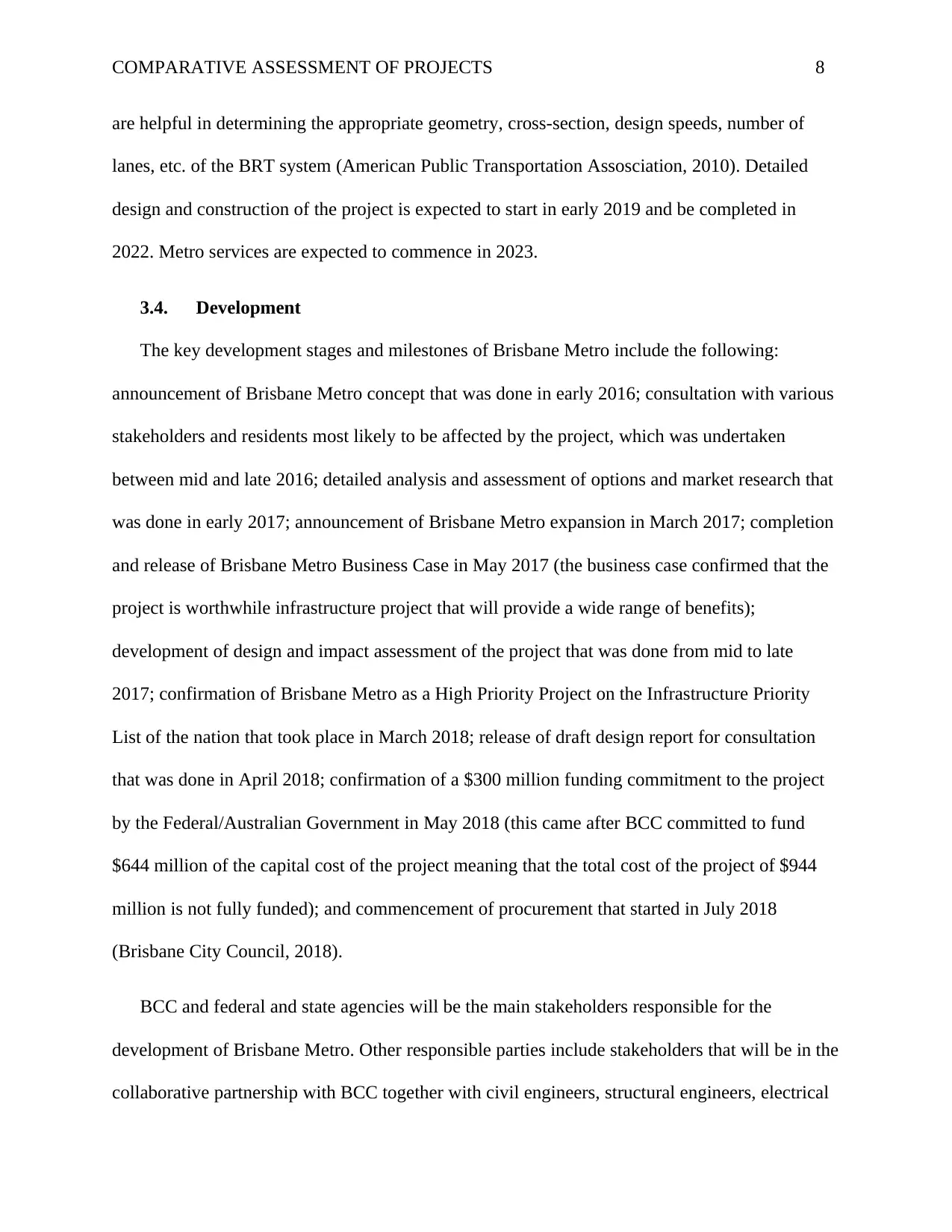
COMPARATIVE ASSESSMENT OF PROJECTS 8
are helpful in determining the appropriate geometry, cross-section, design speeds, number of
lanes, etc. of the BRT system (American Public Transportation Assosciation, 2010). Detailed
design and construction of the project is expected to start in early 2019 and be completed in
2022. Metro services are expected to commence in 2023.
3.4. Development
The key development stages and milestones of Brisbane Metro include the following:
announcement of Brisbane Metro concept that was done in early 2016; consultation with various
stakeholders and residents most likely to be affected by the project, which was undertaken
between mid and late 2016; detailed analysis and assessment of options and market research that
was done in early 2017; announcement of Brisbane Metro expansion in March 2017; completion
and release of Brisbane Metro Business Case in May 2017 (the business case confirmed that the
project is worthwhile infrastructure project that will provide a wide range of benefits);
development of design and impact assessment of the project that was done from mid to late
2017; confirmation of Brisbane Metro as a High Priority Project on the Infrastructure Priority
List of the nation that took place in March 2018; release of draft design report for consultation
that was done in April 2018; confirmation of a $300 million funding commitment to the project
by the Federal/Australian Government in May 2018 (this came after BCC committed to fund
$644 million of the capital cost of the project meaning that the total cost of the project of $944
million is not fully funded); and commencement of procurement that started in July 2018
(Brisbane City Council, 2018).
BCC and federal and state agencies will be the main stakeholders responsible for the
development of Brisbane Metro. Other responsible parties include stakeholders that will be in the
collaborative partnership with BCC together with civil engineers, structural engineers, electrical
are helpful in determining the appropriate geometry, cross-section, design speeds, number of
lanes, etc. of the BRT system (American Public Transportation Assosciation, 2010). Detailed
design and construction of the project is expected to start in early 2019 and be completed in
2022. Metro services are expected to commence in 2023.
3.4. Development
The key development stages and milestones of Brisbane Metro include the following:
announcement of Brisbane Metro concept that was done in early 2016; consultation with various
stakeholders and residents most likely to be affected by the project, which was undertaken
between mid and late 2016; detailed analysis and assessment of options and market research that
was done in early 2017; announcement of Brisbane Metro expansion in March 2017; completion
and release of Brisbane Metro Business Case in May 2017 (the business case confirmed that the
project is worthwhile infrastructure project that will provide a wide range of benefits);
development of design and impact assessment of the project that was done from mid to late
2017; confirmation of Brisbane Metro as a High Priority Project on the Infrastructure Priority
List of the nation that took place in March 2018; release of draft design report for consultation
that was done in April 2018; confirmation of a $300 million funding commitment to the project
by the Federal/Australian Government in May 2018 (this came after BCC committed to fund
$644 million of the capital cost of the project meaning that the total cost of the project of $944
million is not fully funded); and commencement of procurement that started in July 2018
(Brisbane City Council, 2018).
BCC and federal and state agencies will be the main stakeholders responsible for the
development of Brisbane Metro. Other responsible parties include stakeholders that will be in the
collaborative partnership with BCC together with civil engineers, structural engineers, electrical
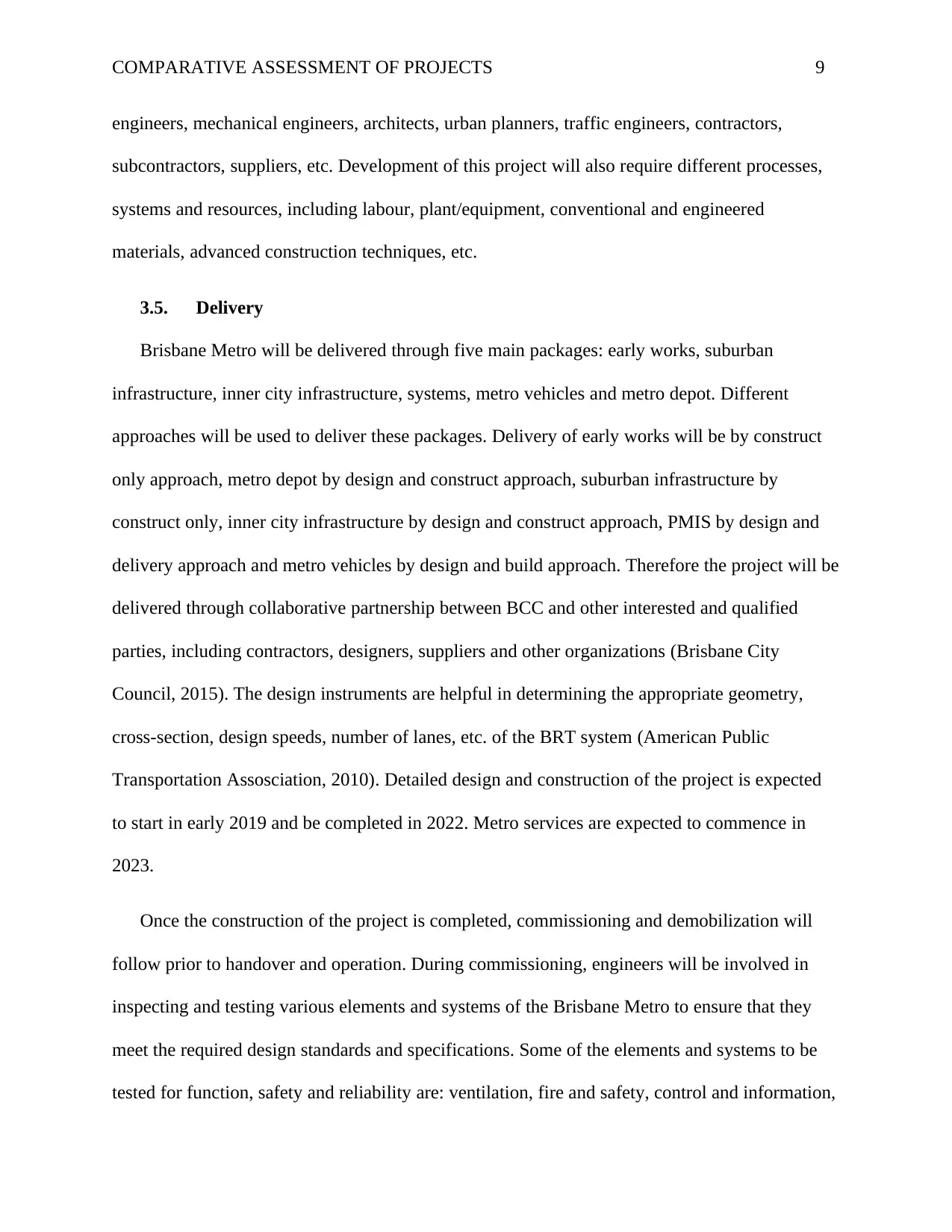
COMPARATIVE ASSESSMENT OF PROJECTS 9
engineers, mechanical engineers, architects, urban planners, traffic engineers, contractors,
subcontractors, suppliers, etc. Development of this project will also require different processes,
systems and resources, including labour, plant/equipment, conventional and engineered
materials, advanced construction techniques, etc.
3.5. Delivery
Brisbane Metro will be delivered through five main packages: early works, suburban
infrastructure, inner city infrastructure, systems, metro vehicles and metro depot. Different
approaches will be used to deliver these packages. Delivery of early works will be by construct
only approach, metro depot by design and construct approach, suburban infrastructure by
construct only, inner city infrastructure by design and construct approach, PMIS by design and
delivery approach and metro vehicles by design and build approach. Therefore the project will be
delivered through collaborative partnership between BCC and other interested and qualified
parties, including contractors, designers, suppliers and other organizations (Brisbane City
Council, 2015). The design instruments are helpful in determining the appropriate geometry,
cross-section, design speeds, number of lanes, etc. of the BRT system (American Public
Transportation Assosciation, 2010). Detailed design and construction of the project is expected
to start in early 2019 and be completed in 2022. Metro services are expected to commence in
2023.
Once the construction of the project is completed, commissioning and demobilization will
follow prior to handover and operation. During commissioning, engineers will be involved in
inspecting and testing various elements and systems of the Brisbane Metro to ensure that they
meet the required design standards and specifications. Some of the elements and systems to be
tested for function, safety and reliability are: ventilation, fire and safety, control and information,
engineers, mechanical engineers, architects, urban planners, traffic engineers, contractors,
subcontractors, suppliers, etc. Development of this project will also require different processes,
systems and resources, including labour, plant/equipment, conventional and engineered
materials, advanced construction techniques, etc.
3.5. Delivery
Brisbane Metro will be delivered through five main packages: early works, suburban
infrastructure, inner city infrastructure, systems, metro vehicles and metro depot. Different
approaches will be used to deliver these packages. Delivery of early works will be by construct
only approach, metro depot by design and construct approach, suburban infrastructure by
construct only, inner city infrastructure by design and construct approach, PMIS by design and
delivery approach and metro vehicles by design and build approach. Therefore the project will be
delivered through collaborative partnership between BCC and other interested and qualified
parties, including contractors, designers, suppliers and other organizations (Brisbane City
Council, 2015). The design instruments are helpful in determining the appropriate geometry,
cross-section, design speeds, number of lanes, etc. of the BRT system (American Public
Transportation Assosciation, 2010). Detailed design and construction of the project is expected
to start in early 2019 and be completed in 2022. Metro services are expected to commence in
2023.
Once the construction of the project is completed, commissioning and demobilization will
follow prior to handover and operation. During commissioning, engineers will be involved in
inspecting and testing various elements and systems of the Brisbane Metro to ensure that they
meet the required design standards and specifications. Some of the elements and systems to be
tested for function, safety and reliability are: ventilation, fire and safety, control and information,
⊘ This is a preview!⊘
Do you want full access?
Subscribe today to unlock all pages.

Trusted by 1+ million students worldwide
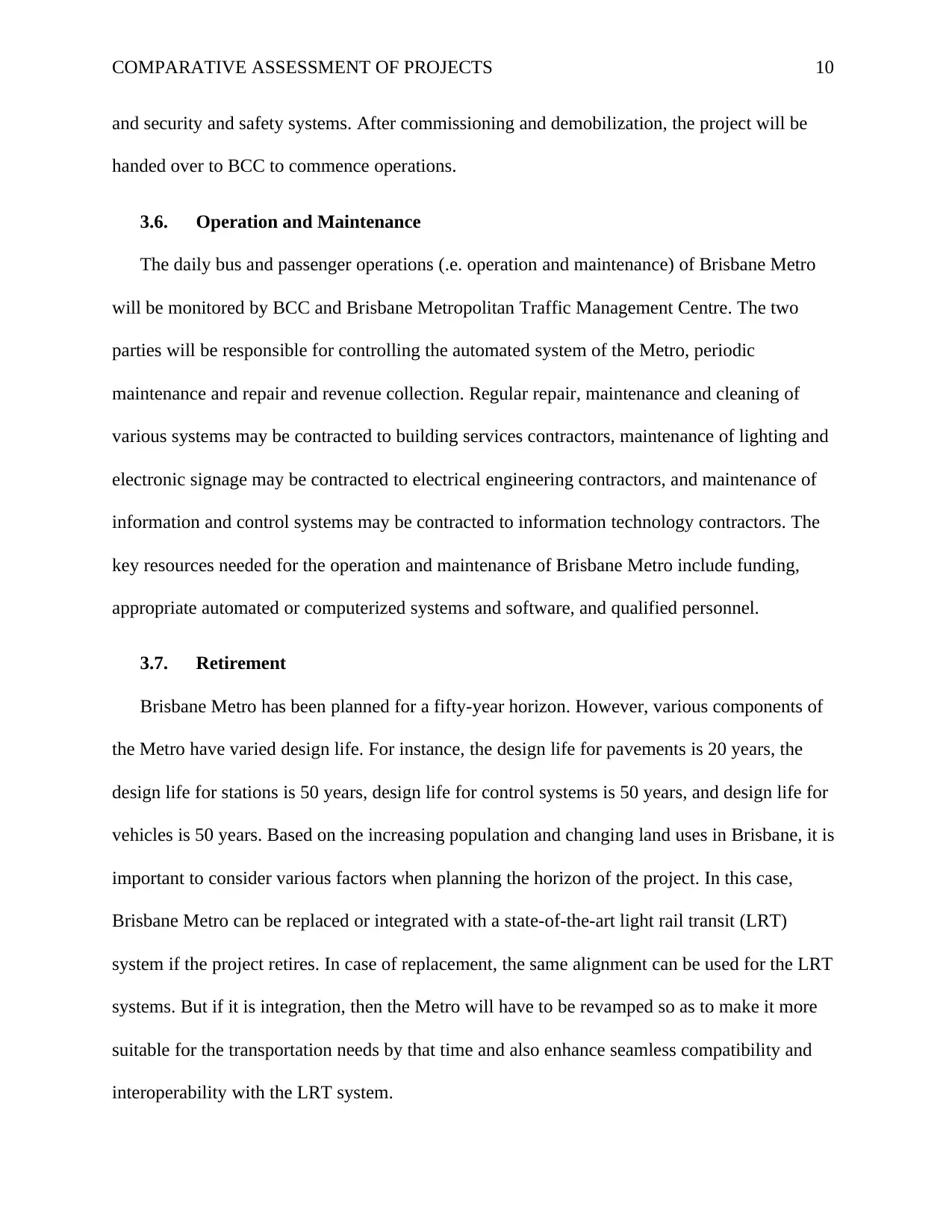
COMPARATIVE ASSESSMENT OF PROJECTS 10
and security and safety systems. After commissioning and demobilization, the project will be
handed over to BCC to commence operations.
3.6. Operation and Maintenance
The daily bus and passenger operations (.e. operation and maintenance) of Brisbane Metro
will be monitored by BCC and Brisbane Metropolitan Traffic Management Centre. The two
parties will be responsible for controlling the automated system of the Metro, periodic
maintenance and repair and revenue collection. Regular repair, maintenance and cleaning of
various systems may be contracted to building services contractors, maintenance of lighting and
electronic signage may be contracted to electrical engineering contractors, and maintenance of
information and control systems may be contracted to information technology contractors. The
key resources needed for the operation and maintenance of Brisbane Metro include funding,
appropriate automated or computerized systems and software, and qualified personnel.
3.7. Retirement
Brisbane Metro has been planned for a fifty-year horizon. However, various components of
the Metro have varied design life. For instance, the design life for pavements is 20 years, the
design life for stations is 50 years, design life for control systems is 50 years, and design life for
vehicles is 50 years. Based on the increasing population and changing land uses in Brisbane, it is
important to consider various factors when planning the horizon of the project. In this case,
Brisbane Metro can be replaced or integrated with a state-of-the-art light rail transit (LRT)
system if the project retires. In case of replacement, the same alignment can be used for the LRT
systems. But if it is integration, then the Metro will have to be revamped so as to make it more
suitable for the transportation needs by that time and also enhance seamless compatibility and
interoperability with the LRT system.
and security and safety systems. After commissioning and demobilization, the project will be
handed over to BCC to commence operations.
3.6. Operation and Maintenance
The daily bus and passenger operations (.e. operation and maintenance) of Brisbane Metro
will be monitored by BCC and Brisbane Metropolitan Traffic Management Centre. The two
parties will be responsible for controlling the automated system of the Metro, periodic
maintenance and repair and revenue collection. Regular repair, maintenance and cleaning of
various systems may be contracted to building services contractors, maintenance of lighting and
electronic signage may be contracted to electrical engineering contractors, and maintenance of
information and control systems may be contracted to information technology contractors. The
key resources needed for the operation and maintenance of Brisbane Metro include funding,
appropriate automated or computerized systems and software, and qualified personnel.
3.7. Retirement
Brisbane Metro has been planned for a fifty-year horizon. However, various components of
the Metro have varied design life. For instance, the design life for pavements is 20 years, the
design life for stations is 50 years, design life for control systems is 50 years, and design life for
vehicles is 50 years. Based on the increasing population and changing land uses in Brisbane, it is
important to consider various factors when planning the horizon of the project. In this case,
Brisbane Metro can be replaced or integrated with a state-of-the-art light rail transit (LRT)
system if the project retires. In case of replacement, the same alignment can be used for the LRT
systems. But if it is integration, then the Metro will have to be revamped so as to make it more
suitable for the transportation needs by that time and also enhance seamless compatibility and
interoperability with the LRT system.
Paraphrase This Document
Need a fresh take? Get an instant paraphrase of this document with our AI Paraphraser

COMPARATIVE ASSESSMENT OF PROJECTS 11
3.8. Research Needs
Efficiency has become one of the major factors in the construction industry. This is mainly
because of the sustainability aspect of construction projects. It is therefore important to conduct
civil engineering research so as to ensure that the Brisbane Metro is designed to achieve the
highest efficiency possible throughout its lifecycle. The research should focus on improving
resource efficiency of the project and making the project sustainable. Some of the resource areas
include: pre-fabricated or volumetric construction approach to improve quality and reduce
delivery time (Lopez & Froese, 2016), use of nanotechnology or engineered nanomaterials to
improve performance; (Silvestre, Silvestre, & de Brito, 2016) and reduce cost and environmental
impacts (Hanus & Harrs, 2013); (Lee, Mahendra, & Alvarez, 2010), use of modern technological
tools or processes such as building information modelling (BIM) to enhance information flow
(Li, et al., 2014); (Masood, Kharal, & Nasir, 2014), implementation of lean construction
principles to minimize waste (Erol, Dikmen, & Birgonul, 2017), and use of recycled and
recyclable materials to enhance sustainability (Bolden, Abu-Lebdeh, & Fini, 2013); (Prezzi,
Bandini, Carraro, & Monteiro, 2011).
4. CIVIL ENGINEERING NEEDS
There are several civil engineering sub-disciplines that are associated with this project. They
include: geotechnical engineering, structural engineering, environmental engineering,
transportation engineering, material engineering, water resources engineering, urban or
municipal engineering, surveying engineering, construction engineering, traffic management
engineering, structures and control engineering (Islamic University, 2018). The relevance of
these sub-disciples is spread throughout the lifecycle of the project.
3.8. Research Needs
Efficiency has become one of the major factors in the construction industry. This is mainly
because of the sustainability aspect of construction projects. It is therefore important to conduct
civil engineering research so as to ensure that the Brisbane Metro is designed to achieve the
highest efficiency possible throughout its lifecycle. The research should focus on improving
resource efficiency of the project and making the project sustainable. Some of the resource areas
include: pre-fabricated or volumetric construction approach to improve quality and reduce
delivery time (Lopez & Froese, 2016), use of nanotechnology or engineered nanomaterials to
improve performance; (Silvestre, Silvestre, & de Brito, 2016) and reduce cost and environmental
impacts (Hanus & Harrs, 2013); (Lee, Mahendra, & Alvarez, 2010), use of modern technological
tools or processes such as building information modelling (BIM) to enhance information flow
(Li, et al., 2014); (Masood, Kharal, & Nasir, 2014), implementation of lean construction
principles to minimize waste (Erol, Dikmen, & Birgonul, 2017), and use of recycled and
recyclable materials to enhance sustainability (Bolden, Abu-Lebdeh, & Fini, 2013); (Prezzi,
Bandini, Carraro, & Monteiro, 2011).
4. CIVIL ENGINEERING NEEDS
There are several civil engineering sub-disciplines that are associated with this project. They
include: geotechnical engineering, structural engineering, environmental engineering,
transportation engineering, material engineering, water resources engineering, urban or
municipal engineering, surveying engineering, construction engineering, traffic management
engineering, structures and control engineering (Islamic University, 2018). The relevance of
these sub-disciples is spread throughout the lifecycle of the project.
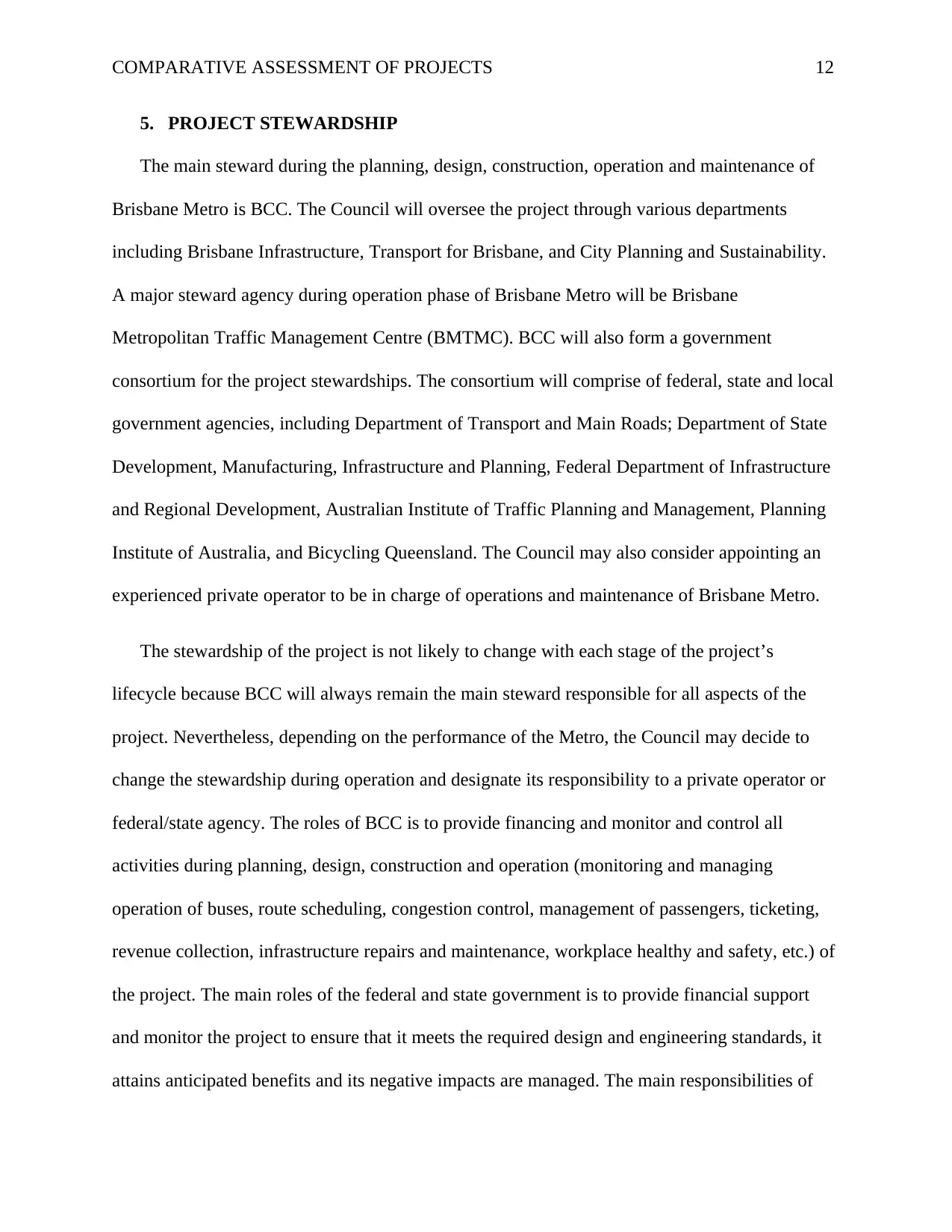
COMPARATIVE ASSESSMENT OF PROJECTS 12
5. PROJECT STEWARDSHIP
The main steward during the planning, design, construction, operation and maintenance of
Brisbane Metro is BCC. The Council will oversee the project through various departments
including Brisbane Infrastructure, Transport for Brisbane, and City Planning and Sustainability.
A major steward agency during operation phase of Brisbane Metro will be Brisbane
Metropolitan Traffic Management Centre (BMTMC). BCC will also form a government
consortium for the project stewardships. The consortium will comprise of federal, state and local
government agencies, including Department of Transport and Main Roads; Department of State
Development, Manufacturing, Infrastructure and Planning, Federal Department of Infrastructure
and Regional Development, Australian Institute of Traffic Planning and Management, Planning
Institute of Australia, and Bicycling Queensland. The Council may also consider appointing an
experienced private operator to be in charge of operations and maintenance of Brisbane Metro.
The stewardship of the project is not likely to change with each stage of the project’s
lifecycle because BCC will always remain the main steward responsible for all aspects of the
project. Nevertheless, depending on the performance of the Metro, the Council may decide to
change the stewardship during operation and designate its responsibility to a private operator or
federal/state agency. The roles of BCC is to provide financing and monitor and control all
activities during planning, design, construction and operation (monitoring and managing
operation of buses, route scheduling, congestion control, management of passengers, ticketing,
revenue collection, infrastructure repairs and maintenance, workplace healthy and safety, etc.) of
the project. The main roles of the federal and state government is to provide financial support
and monitor the project to ensure that it meets the required design and engineering standards, it
attains anticipated benefits and its negative impacts are managed. The main responsibilities of
5. PROJECT STEWARDSHIP
The main steward during the planning, design, construction, operation and maintenance of
Brisbane Metro is BCC. The Council will oversee the project through various departments
including Brisbane Infrastructure, Transport for Brisbane, and City Planning and Sustainability.
A major steward agency during operation phase of Brisbane Metro will be Brisbane
Metropolitan Traffic Management Centre (BMTMC). BCC will also form a government
consortium for the project stewardships. The consortium will comprise of federal, state and local
government agencies, including Department of Transport and Main Roads; Department of State
Development, Manufacturing, Infrastructure and Planning, Federal Department of Infrastructure
and Regional Development, Australian Institute of Traffic Planning and Management, Planning
Institute of Australia, and Bicycling Queensland. The Council may also consider appointing an
experienced private operator to be in charge of operations and maintenance of Brisbane Metro.
The stewardship of the project is not likely to change with each stage of the project’s
lifecycle because BCC will always remain the main steward responsible for all aspects of the
project. Nevertheless, depending on the performance of the Metro, the Council may decide to
change the stewardship during operation and designate its responsibility to a private operator or
federal/state agency. The roles of BCC is to provide financing and monitor and control all
activities during planning, design, construction and operation (monitoring and managing
operation of buses, route scheduling, congestion control, management of passengers, ticketing,
revenue collection, infrastructure repairs and maintenance, workplace healthy and safety, etc.) of
the project. The main roles of the federal and state government is to provide financial support
and monitor the project to ensure that it meets the required design and engineering standards, it
attains anticipated benefits and its negative impacts are managed. The main responsibilities of
⊘ This is a preview!⊘
Do you want full access?
Subscribe today to unlock all pages.

Trusted by 1+ million students worldwide
1 out of 24
Related Documents
Your All-in-One AI-Powered Toolkit for Academic Success.
+13062052269
info@desklib.com
Available 24*7 on WhatsApp / Email
![[object Object]](/_next/static/media/star-bottom.7253800d.svg)
Unlock your academic potential
Copyright © 2020–2025 A2Z Services. All Rights Reserved. Developed and managed by ZUCOL.



